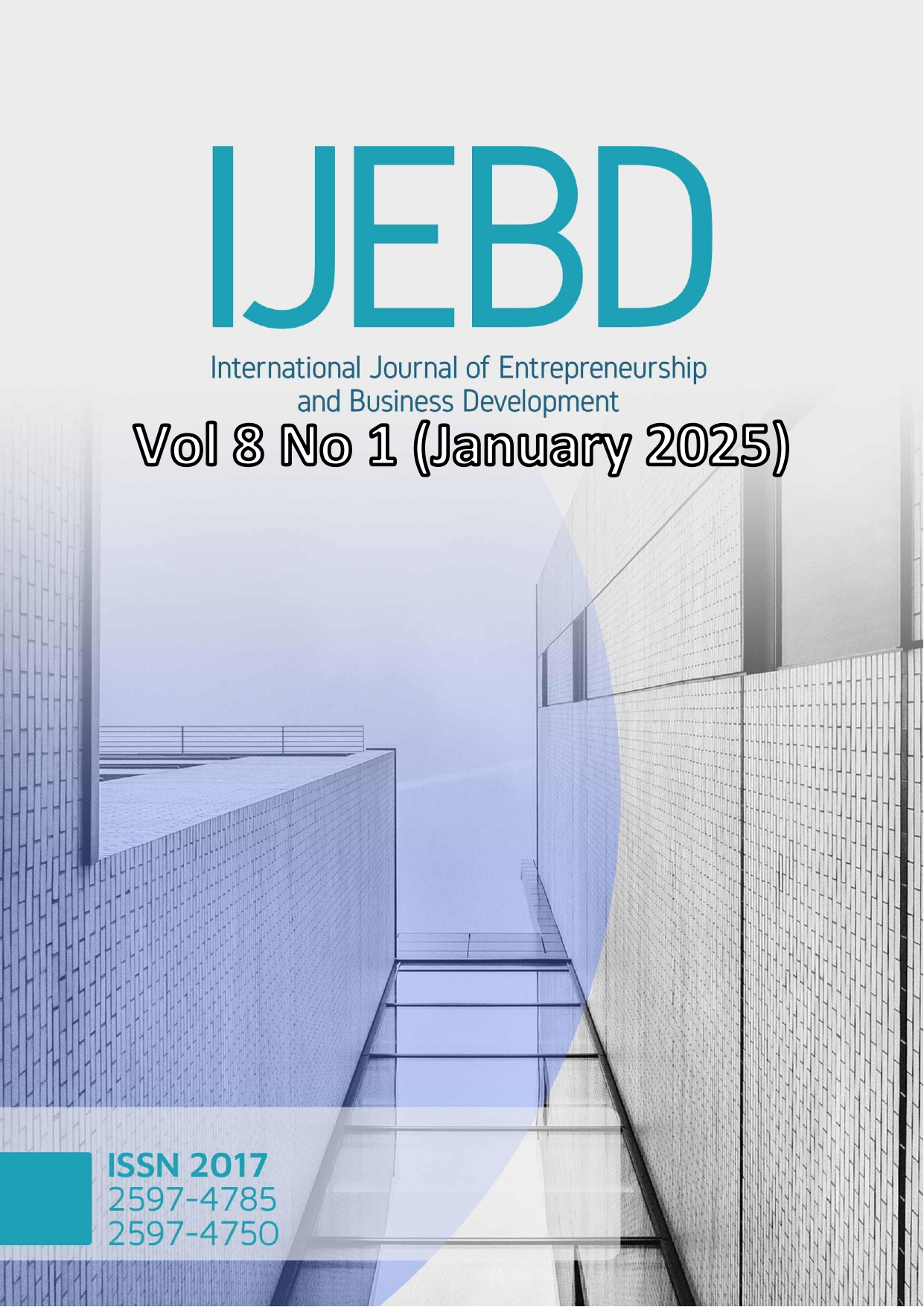Organizational Capacity Development and Innovation: The Case of Tunisian High-Tech Companies
Abstract
This article examines the impact of organizational capacity development on the innovation potential of companies.
Based on a survey conducted with 32 high-tech sector companies, the study highlights that enhancing skills, knowledge, and resources within organizations promotes their ability to innovate.
Statistical analysis, carried out using SPSS version 25, confirms a positive correlation between these organizational capacities and company performance.
This underscores their crucial role in ensuring survival and growth in an ever-evolving economic environment.
Keywords: Innovation, organizational capacity, innovation potential.
Downloads
References
• Teece, D. J. (2023). "The Dynamic Capabilities Framework: How Firms Navigate and Compete in a Rapidly Changing World." Strategic Management Journal, 44(4), 849-875. DOI: 10.1002/smj.3325
• Pisano, G. P. (2022). "The Challenge of Innovation: How to Improve Your Innovation Skills." Harvard Business Review, 100(5), 76-83.
• Christensen, C. M., Raynor, M. E., & McDonald, R. (2023). "What is Disruptive Innovation?" Harvard Business Review, 101(1), 44-54.
• Dyer, J. H., Gregersen, H. B., & Christensen, C. M. (2024). The Innovator's DNA: Mastering the Five Skills of Disruptive Innovators. Harvard Business Review Press.
• Schilling, M. A. (2021). Strategic Management of Technological Innovation. McGraw-Hill Education. • OECD. (2023). "Innovation in Firms: Results from the OECD Innovation Survey." OECD Publishing, Paris. doi:10.1787/6a2925e6-en.
• Grant, R. M. (1991). "The Resource-Based Theory of Competitive Advantage: Implications for Strategy Formulation." California Management Review, 33(3), 114-135. doi:10.2307/41166664.
• Collis, D. J. (1994). "Research Note: How Valuable are Organizational Capabilities?" Strategic Management Journal, 15(S1), 143-152. doi:10.1002/smj.4250150911.
• Zollo, M., & Winter, S. G. (2002). "Deliberate Learning and the Evolution of Dynamic Capabilities." Organization Science, 13(3), 339-351. doi:10.1287/orsc.13.3.339.2780.
• Nonaka, I., & Takeuchi, H. (2019). The Knowledge-Creating Company: How Japanese Companies Create the Dynamics of Innovation. Oxford University Press.
• Teece, D. J., Pisano, G., & Shuen, A. (1997). "Dynamic Capabilities and Strategic Management." Strategic Management Journal, 18(7), 509-533. doi:10.1002/smj.1530.
• Freel, M. S., & Roberts, J. (2023). "The Role of Skills in Innovation: An Empirical Study." Technovation, 111, 102516. doi: 10.1016/j.technovation.2023.102516.
• Huang, K. F., & Liu, C. H. (2023). "Resource Allocation for Innovation: Balancing Resources Between Radical and Incremental Innovations." Journal of Business Research, 143, 908-920.doi:10.1016/j.jbusres.2022.12.024.
• Carrier, C., & Julien, P. A. (2024). "The Role of Skills and Capabilities in the Innovation Process of SMEs." International Journal of Entrepreneurship and Innovation Management, 28(1),85-101.doi:10.1504/IJEIM.2024.10022641.
• Romijn, H., & Albaladejo, M. (2023). "Determinants of Innovation Capability in Developing Countries: A Case Study of Vietnam." Research Policy, 52(3), 104565. doi: 10.1016/j.respol.2022.104565.
• Tsai, W., Moskowitz, D., & Lee, Y. (2023). "Organizational Learning and Innovation: The Role of Human Capital." Journal of Organizational Behavior, 44(4), 635-651. doi:10.1002/job.2588.
• Evrard, Y., Pras, B., & Roux, E. (2003). Market: Studies and Research. Dunod. • Hair, J. F., Hult, G. T. M., Ringle, C. M., & Sarstedt, M. (2021). A Primer on Partial Least Squares Structural Equation Modeling (PLS-SEM). SAGE Publications.
• Teece, D. J. (2022). Dynamic Capabilities and Strategic Management: Organizing for Innovation and Growth. Oxford University Press. • Pisano, G. P. (2019). Creative Construction: The DNA of Sustained Innovation. PublicAffairs.
• Chesbrough, H. W. (2020). Open Innovation: The New Imperative for Creating and Profiting fromTechnology.HarvardBusinessReviewPress.
• Edmondson, A. C., & Gino, F. (2023). "The Importance of Psychological Safety for Learning andInnovation."HarvardBusinessReview.
• Grant, R. M. (2021). Contemporary Strategy Analysis. John Wiley & Sons.
• Zollo, M., & Winter, S. G. (2002). "Deliberate Learning and the Evolution of Dynamic Capabilities." Organization Science, 13(3), 339-351.
• Nonaka, I., & Takeuchi, H. (2023). "The New New Product Development Game." Harvard Business,Review.
• Hamel, G., & Prahalad, C. K. (1994). Competing for the Future. Harvard Business Review Press.
• Gawer, A., & Cusumano, M. A. (2022). "Industry Platforms and Ecosystem Innovation." ResearchPolicy,51(1), 104-132.
• Creswell, J. W., & Poth, C. N. (2018). Qualitative Inquiry and Research Design: Choosing AmongFiveApproachesSagePublications.
• Saunders, M., Lewis, P., & Thornhill, A. (2019). Research Methods for Business Students. Pearson.
• Yin, R. K. (2018). Case Study Research and Applications: Design and Methods. Sage Publications.
• Sekaran, U., & Bougie, R. (2019). Research Methods for Business: A Skill-Building Approach. Wiley.
• Resnik, D. B. (2020). "What Is Ethics in Research & Why Is It Important?" National Institutes ofHealth.
• Barney, J. (1991). "Firm Resources and Sustained Competitive Advantage." Journal of Management,17(1),99-120.
• Pallant, J. (2020). SPSS Survival Manual: A Step by Step Guide to Data Analysis Using IBM SPSS.Routledge.
• Field, A. (2018). Discovering Statistics Using IBM SPSS Statistics. Sage Publications.
• Hair, J. F., Hult, G. T. M., Ringle, C. M., & Sarstedt, M. (2022). A Primer on Partial Least Squares Structural Equation Modeling (PLS-SEM). Sage Publications.
Copyright (c) 2025 IJEBD (International Journal of Entrepreneurship and Business Development)

This work is licensed under a Creative Commons Attribution-ShareAlike 4.0 International License.














